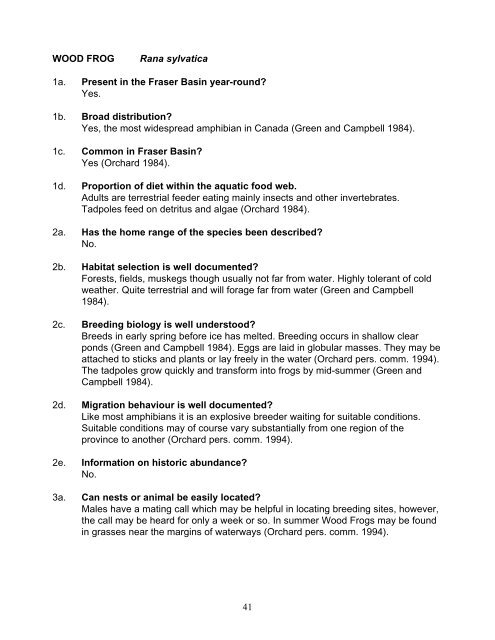Assessment of Potential Indicator Species for Monitoring ...
Assessment of Potential Indicator Species for Monitoring ...
Assessment of Potential Indicator Species for Monitoring ...
Create successful ePaper yourself
Turn your PDF publications into a flip-book with our unique Google optimized e-Paper software.
WOOD FROG Rana sylvatica<br />
1a. Present in the Fraser Basin year-round?<br />
Yes.<br />
1b. Broad distribution?<br />
Yes, the most widespread amphibian in Canada (Green and Campbell 1984).<br />
1c. Common in Fraser Basin?<br />
Yes (Orchard 1984).<br />
1d. Proportion <strong>of</strong> diet within the aquatic food web.<br />
Adults are terrestrial feeder eating mainly insects and other invertebrates.<br />
Tadpoles feed on detritus and algae (Orchard 1984).<br />
2a. Has the home range <strong>of</strong> the species been described?<br />
No.<br />
2b. Habitat selection is well documented?<br />
Forests, fields, muskegs though usually not far from water. Highly tolerant <strong>of</strong> cold<br />
weather. Quite terrestrial and will <strong>for</strong>age far from water (Green and Campbell<br />
1984).<br />
2c. Breeding biology is well understood?<br />
Breeds in early spring be<strong>for</strong>e ice has melted. Breeding occurs in shallow clear<br />
ponds (Green and Campbell 1984). Eggs are laid in globular masses. They may be<br />
attached to sticks and plants or lay freely in the water (Orchard pers. comm. 1994).<br />
The tadpoles grow quickly and trans<strong>for</strong>m into frogs by mid-summer (Green and<br />
Campbell 1984).<br />
2d. Migration behaviour is well documented?<br />
Like most amphibians it is an explosive breeder waiting <strong>for</strong> suitable conditions.<br />
Suitable conditions may <strong>of</strong> course vary substantially from one region <strong>of</strong> the<br />
province to another (Orchard pers. comm. 1994).<br />
2e. In<strong>for</strong>mation on historic abundance?<br />
No.<br />
3a. Can nests or animal be easily located?<br />
Males have a mating call which may be helpful in locating breeding sites, however,<br />
the call may be heard <strong>for</strong> only a week or so. In summer Wood Frogs may be found<br />
in grasses near the margins <strong>of</strong> waterways (Orchard pers. comm. 1994).<br />
41














